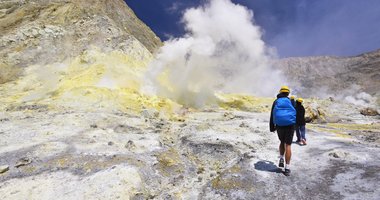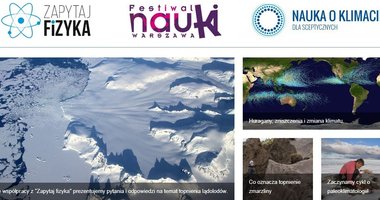
Atmospheric Physics Department, IGF FUW
The weather today or tomorrow, short-term climate fluctuations, or its radical changes – all of these processes are strongly affected by the physical phenomena taking place in the atmosphere. The biggest source of uncertainty in weather and climate models are clouds and aerosols. This is why we study them in particular detail. We conduct our research using both theoretical (mainly numerical) and experimental methods, in the field and in our laboratories. We are particularly interested in cloud microphysics, i.e. the physical processes on the small spatial scale, responsible for the formation of rain and cloud disappearance.
We look especially closely at the physics of the phenomena occurring at the interface of clouds and clear air, where the processes of condensation, evaporation, turbulence, and radiative energy transfer play an important role. We conduct our research in a cloud chamber as well as in natural conditions, during international measurement campaigns using planes. One of our means of collecting data is the UltraFast Thermometer (UFT) developed in our Institute. While a plane flies through a cloud, it measures the changes in air temperature inside the cloud with even a centimeter resolution.
Modern cloud research would be impossible without numerical methods and the tools they provide. The numerical approach is used to solve equations describing the physical processes occurring in the scales ranging from millimeters (activation, growth by condensation, and by collision-coalescence) to hundreds of kilometers (global circulation, wave, and disturbance propagation). Our Institute has been using and developing numerical tools for many years now. In collaboration with the National Center for Atmospheric Research in Boulder, USA, (NCAR) and the European Centre for Medium-Range Weather Forecasts (ECMWF) in the United Kingdom, we use and refine, among others, the EULAG model (Eulerian/semi-Lagrangian fluid solver), known to many scientists, as well as the Lagrangian Cloud Model. The latter combines the cloud-scale flow calculated through large eddy simulation (LES) with a Lagrangian description of cloud particles.
Our scientists also conduct research on the influence of atmospheric aerosol on the climate system. We study how the solar radiant flux on the surface changes depending on the physical properties of aerosol, and how it impacts the weather and climate in Europe and in the Arctic. We conduct research using in-situ methods as well as remote sensing instruments localized in the Radiative Transfer Laboratory and the Remote Sensing Laboratory. Our equipment includes a unique, multichannel PollyXT lidar, which is part of the EARLINET observational network. It performs aerosol measurements both in near range and in far range. We conduct research on aerosol in Poland as part of the Poland-AOD network. Our focus is on studying the optical properties of aerosol during smog episodes and influxes of long-range pollution emitted in biomass burning and sandstorms. We have a broad range of interests. In one of our projects, we modeled the clear sky turbulence using data collected by commercial transport planes. In collaboration with the Poznań University of Life Sciences, we also study the connection between atmospheric aerosol and the productivity of peat bogs.
Theoretical modeling and computer simulations allow us to study the properties of comets and planets in the Solar System. To better understand the geophysical mechanisms operating in the interior and on the surfaces of comets, in our laboratory we experimentally study the analogs of cometary ice in conditions close to the vacuum of space. The results of the experiments, in an appropriately adapted vacuum chamber, combined with theoretical models and computer simulations, allow us to better understand the comet environment. Using numerical simulations, we also model the condensation and sublimation processes of surface and ground ice on Mars and the melting of ice on its surface.
We are the only teaching unit in Poland educating second-cycle degree students in accordance with the World Meteorological Organization guidelines. Graduates of our programs are specialists skilled in numerical modeling of atmospheric processes (with applications in numerical weather forecasting and climate change projections), able to reliably interpret and process measurement data acquired through remote sensing and in-situ methods, as well as acquainted with databases and specialized software for meteorological data analysis and processing.
The Atmospheric Physics Department consists of the following research groups:
-
Atmospheric aerosol (dr hab. Iwona S. Stachlewska, prof. UW, dr hab. Krzysztof Markowicz, prof. UW) - the group conducts research on the direct impact of aerosols on the climate system. The research studies are based on observations and modeling of the short- and long-wave radiation transfer in the atmosphere. The optical and microphysical properties of atmospheric aerosols based on in-situ measurements, active and passive remote sensing as well as numerical simulations are studied.
-
Cloud dynamics and atmospheric turbulence (prof. dr hab. Szymon P. Malinowski) - the group conducts research on the dynamics of clouds in the full range of scales from the movement of individual droplets to flows in the scale of clouds and cloud systems. The focus is on the phenomenon of turbulence and (direct and indirect) influence of small- and moderate-scale turbulence in clouds and surrounding atmosphere on larger-scale flows like weather patterns and even general circulation.
- Microphysics of clouds (prof. dr hab. Hanna Pawłowska) - the group conducts research on the microphysics and dynamics of convective clouds in a wide range of spatial and temporal scales: from the detailed microphysics of individual aerosol and cloud droplets (activation, growth by condensation, and collision-coalescence), to the motion of the whole cloud.
Studies:



